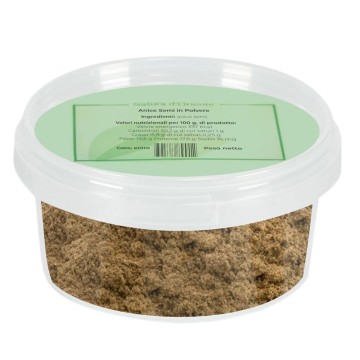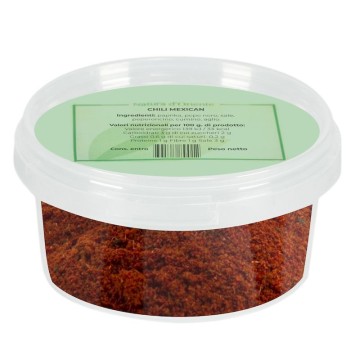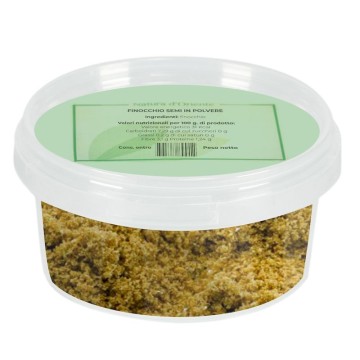Anise seed powder: properties and benefits
Anise powder is ground from dried whole fruits, bones from anise seeds, and takes their gray-brown hue. In the kitchen this powder is known for giving the qualities of anise in an intense way. It has a sweet and persistent odor, a warm flavor similar to that of liquorice, fennel and star anise - with less intensity.
Like other spices, aniseed powder not only gives foods and drinks an aromatic element, but is also useful for its digestive qualities. It gently stimulates the appetite and has been used to promote correct digestion and stomach-related disorders. Helps against flatulence, promoting the elimination of intestinal gas; facilitates correct transit of food by facilitating the balance of the bacterial flora in the intestine. Anise helps reduce stomach acid secretion and irritation, protecting the gastric mucosa.
Its properties are due to the content of antioxidants, essential oil and several bioactive agents - in particular compounds such as flavonoid glycosides and anethole.
In the herbal tradition, anise is used in herbal teas and infusions for its properties that help regular gastrointestinal motility and gastroprotection. An anise infusion helps to deflate the belly, especially in combination with fennel; also used for laxative and diuretic effects. The powder from the processing of dried seeds can be useful in infusions even during the winter period also for an expectorant action, which promotes the fluidity of bronchial secretions, for the well-being of the nose and throat. At the same time, it is useful for bad breath and the well-being of the oral cavity.
Anise has historically also been used as a natural preservative, given that during grinding and cooking it releases anethole – this substance has qualities capable of slowing down the decay of products from ovens and the attack of mold or fungi. In terms of nutritional values, we have seen that anise contains anethole, as well as fatty acids and antioxidants such as flavonoids and coumarins, eugenol, estragole. Furthermore, it is a source of mineral salts such as iron, copper, phosphorus, magnesium and other nutrients.
Anise is generally a safe food, but some people may show allergic reactions; especially those who have already experimented with plants of the same family, such as fennel, celery, parsley or dill.
Origins and history of cultivation
Anise has been known since ancient times both as a flavoring and as a remedy in folk medicine. It derives from the annual green anise plant, Pimpinella anisum which belongs to the Apiaceae family. This botanical family also includes carrots, cumin, cumin, dill, fennel and coriander. It comes from Asia or the Middle East, but as a plant over the centuries it has spread to many continents and today we find it in Turkey, Iran, Egypt, India, in the Mediterranean and in many territories with a warm climate - including Italy. It has been present on the American continent since the time of Columbus.
Pimpinella anisum shows small white-yellow flowers followed by small oval seeds, from green to yellow. The anise seed is actually the edible fruit of the plant. It is dried and then ground to make aniseed powder.
Historically, anise has been used in food since the time of the Egyptians, perhaps the first people to discover its benefits at the table, and to create decoctions against coughs and aches of throat. The ancient Romans appreciated the digestive qualities of anise, present in banquets as a spice and also in the wedding cake with aniseed, called mustaceus. Furthermore, they used it as a mucolytic and to treat insomnia (it was considered a relaxant) and they considered it an aphrodisiac.
For many centuries in Europe people used to chew anise seeds after meals, up until today's herbal teas. In medieval times it was used as a remedy for colds and respiratory problems, and to calm headaches. In the Middle East, a traditional anise tea is taken by breastfeeding mothers to avoid the colic typical of babies. Much appreciated in Northern Europe, it was even the subject of a tax in England.
The powdered spice has also been used as a natural insecticide, anethole helps as an insect repellent.
Using aniseed powder in cooking
The powdered version is convenient and practical for flavoring foods and for cooking, and its aroma makes every recipe unmistakable. Thanks to its spicy and particular flavor, anise seed powder is often added to sweet recipes such as cakes, biscuits, baked goods, soups, drinks, syrups and infusions. A pinch of anise powder is also a natural sweetener.
In particular, powdered anise is used in vegetable dishes, roasted carrots, stews and Indian curries. Widely used for bread and desserts in Scandinavia, it is perfect in a blend of spices to balance the flavors of cinnamon and pair with cumin.
In drinks, powdered anise is used to flavor liqueurs famous in France such as pastis, anisette, Pernod and Ricard, absinthe or other traditions such as sambuca, ouzo and raki. In pastry making it evokes menthol and liquorice, and for these fresh notes it is used on ice creams and sweets and jellies. Anise powder is perfect for giving an unmistakable touch to plant-based milk
For savory dishes, the versatility of anise becomes excellent on fish dishes, such as seafood, and is also used to flavor the cooking of roasted white meats such as pork and chicken. Its sweet and warm spicy tone fits with some vegetables and goat cheeses, convenient as a condiment in the powdered version. Grinding anise seeds also makes it easy to include them in sauces for meat and fish, in some tomato sauces (a pinch is enough) and on risottos. It can also be used for anise butter, adding the powder after crushing it with a fork - after placing it in the fridge to let it recompact and use, this butter becomes an excellent flavoring in recipes.
For infusion, you can use 2-3 grams of anise seed powder in a cup of boiling water (250 ml), to infuse for about 10 minutes .
In spice combinations, anise pairs well with: fennel seeds, cardamom, star anise, cinnamon, cloves, cumin, coriander, nutmeg and allspice.
Anise spiced bread
Ingredients: 250 ml (1 cup) whole milk - 500 g flour – 60 g (4 tablespoons) salted butter – 40 g (3 tablespoons) of sugar – 7.5 g of table salt – 7 g of active dry yeast – 60 ml (¼ cup) of warm water – 1 large beaten egg - ¼ teaspoon of powdered anise seeds (or 1 tablespoon of dried anise seeds ) - sesame seeds to sprinkle at the end
Preparation Place the milk and butter in a medium saucepan and heat over medium-high heat. Stirring occasionally, until the butter melts.
Add and mix the sugar and salt
. Remove from heat and let cool to no higher than 110 degrees.
Dissolve the yeast in ¼ cup warm water (around 250 degrees F), and set aside.
Put the yeast mixture cooled milk in a large bowl and, using the whisk attachment of an electric mixer, combine ½ cup flour (64 g).
Combine ½ beaten egg, the aniseed powder and then the yeast.
Use the mixer with the spiral (dough hook) and keeping the machine on speed 2. To form the dough, add just enough flour to combine, ½ cup at a time.
Beat until the dough sticks to the hook and clears the sides of the mixer (about 2 minutes) Knead an additional 2 minutes on speed 2 or until the dough is smooth and elastic.
Remove the dough from the mixer and roll it out on a lightly floured surface. Knead by hand to check the soft consistency.
Transfer the dough to a large greased bowl, turning once to coat the surface. Cover with a clean cloth and leave to rise in a warm place for about 45-60 minutes or until the mass has doubled.
Preheat the oven to 230°C in static mode. Grease two baking trays. Pinch the dough and knead it briefly to release additional air. Divide the dough in half and shape each half into an oblong loaf, which will fill the prepared pans; put on trays.
Brush the surface with the remaining beaten egg and sprinkle it with the sesame seeds. Bake in the oven for about 35 minutes, halfway through cooking it is better to lower the temperature to 200°. Bake until the loaves are golden brown and feel hollow when tapped. Remove from the pan and let cool completely on a rack.









 No reward points for this product.
No reward points for this product.















